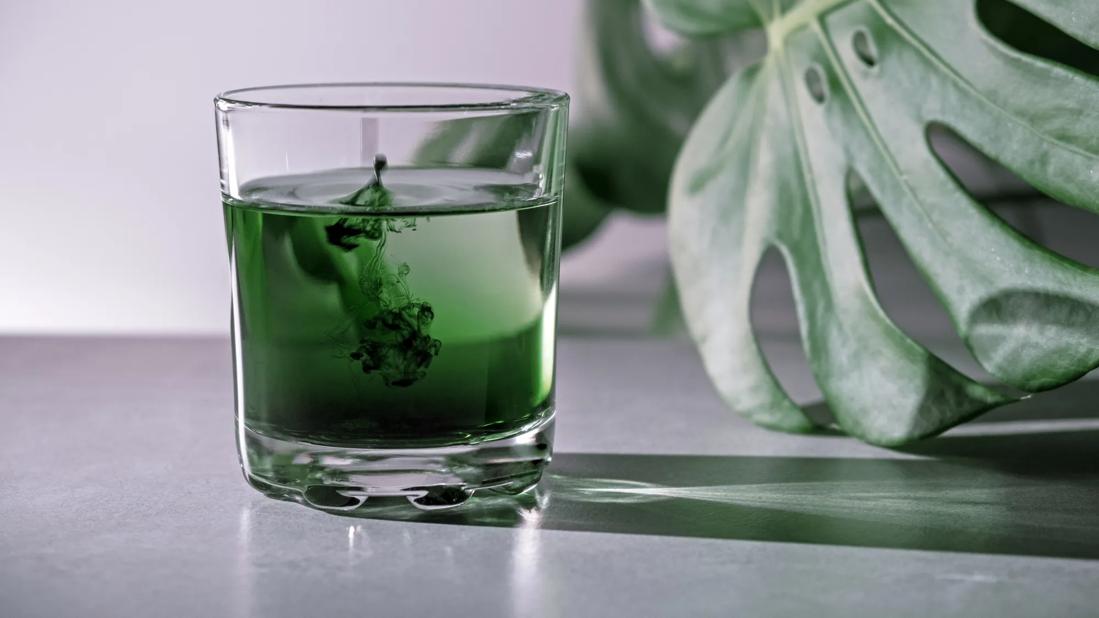There are plenty of claims that the pigment can improve acne, promote weight loss and more — but the research is lacking

Thanks to your middle school science knowledge, you probably know that chlorophyll is what gives plants their green color. But can chlorophyll also improve your health?
Advertisement
Cleveland Clinic is a non-profit academic medical center. Advertising on our site helps support our mission. We do not endorse non-Cleveland Clinic products or services. Policy
While there’s plenty of chatter around how chlorophyll can help with everything from your skin to boosting your energy, there’s very little evidence to back up those claims, says registered dietitian Beth Czerwony, RD, LD.
Chlorophyll is a pigment that plays a critical role in photosynthesis. Photosynthesis is the process whereby plants absorb energy from sunlight to create nutrients. Many consider chlorophyll the foundation of all life on Earth, given its critical role in sustaining the plants that serve as the building blocks in the planet’s food chain.
But when you use chlorophyll drops, you’re not using pure chlorophyll. The green liquid supplement that’s dripped into drinks is actually chlorophyllin, a semi-synthetic mixture of sodium copper salts derived from chlorophyll. (Chlorophyllin is also available as pills, powders, gummies and ointments.)
So, what does chlorophyll do? While research has verified that chlorophyll contains certain antioxidant and anti-inflammatory properties, Czerwony cautions against it being considered a cure-all, especially as most studies on chlorophyll are old and used a small sample size.
“If something truly worked,” Czerwony says, “it’s safe to say it wouldn’t be a secret just exposed to the world through TikTok. There’s reason for skepticism.”
Advertisement
So, let’s take a look at the claims around chlorophyll benefits and dive into what the research shows.
There’s been some research around topical chlorophyll and its potential to improve acne, pore size and sun damage. But it’s important to note that these studies were small-scale in size — with around 10 people per study.
A few small studies, which used an ointment of papain (an enzyme), urea (an organic compound) and chlorophyllin, noted an improvement in inflammation and bacterial growth on wounds. But larger studies are needed to confirm these preliminary findings.
Can liquid chlorophyll supplements help you lose weight? It’s hard to say, as research in this area is limited. One study with 38 female participants found that a green plant membrane supplement (which included chlorophyll) resulted in more weight loss than participants who didn’t take the supplement. But, again, more research is needed.
There’s research around using chlorophyll as a natural deodorant. But it should be noted that many of these studies are outdated and have mixed results. And there’s not a lot of evidence around the pigment’s ability to reduce bad breath.
If you’re feeling constipated or have gas, could a chlorophyll supplement help? Research shows that it may help reduce inflammation from inflammatory bowel disease (IBD). Another study points to chlorophyll’s antioxidant properties as a theory on why it may help reduce inflammation, while experimental models point to chlorophyll’s ability to regulate gut microbiota. But Czerwony stresses the importance of larger, longer studies to fully understand how chlorophyll can benefit gut health.
Sure, plants get their energy from chlorophyll. So, shouldn’t human bodies reap the same benefit? Not so fast, cautions Czerwony. There’s little evidence that chlorophyll supplements can give you an energy boost.
There have been various studies on how chlorophyll can prevent or reduce cancer, such as pancreatic, colon, liver and lung cancer. And while those lab studies show some promise, more research is still needed in humans.
Researchers at Oregon State University’s Linus Pauling Institute found no toxic effects attributed to chlorophyllin in decades of human use. Czerwony says it appears safe when used in moderation.
But there are some potential side effects such as:
Going back to those middle school science lessons, it seems that chlorophyllin maintains some of chlorophyll’s ability to act as a photosensitizer.
“Would I recommend chlorophyll? No,” states Czerwony. “Plants need chlorophyll far more than we do. It’s really not necessary for humans. But if you wanted to try it, there’s no real harm.”
If you really want to boost your chlorophyll intake, she says there’s a more natural way than searching out supplement bottles. Just steer your grocery cart into the produce aisle and fill it with green vegetables.
Advertisement
Foods rich in chlorophyll include recipe-ready produce such as spinach, kale, green beans and peas. Better yet, each of those options includes fiber, vitamins and other nutrients not packed into chlorophyll drops.
There’s another side benefit to going the grocery route, too: “A bottle of chlorophyll drops isn’t cheap,” Czerwony shares. “From a health standpoint, you’d be better off spending the money on vegetables.”
Advertisement
Learn more about our editorial process.
Advertisement

The meat-based elimination diet restricts important food groups — like fruits and vegetables — that keep you healthy

Eat your fill of vitamins C, B6 and E, plus zinc and selenium

The vitamins, minerals and other nutrients in the food you eat are essential for a healthy heart, but supplements are another story

Early research shows that this supplement may help, but more studies are needed

The natural supplement may help with weight loss, lower blood sugar and protect your heart

Over-the-counter pills, powders, extracts and tinctures can interact with other medications and cause unexpected side effects

This sticky phytocomplex may have health benefits — but the science and safety data is lacking

The pros and cons of taking prenatal vitamins when you’re not pregnant depend on your age, ethnicity and health

Start having sex about 72 hours before ovulation, then at least every other day during your fertile window

Attachment theory suggests that your earliest relationships shape connections throughout your life

It isn’t a recognized mental health disorder, but research shows that problematic social media use can negatively affect your mental health, self-esteem and sleep